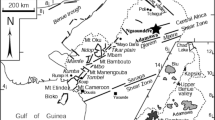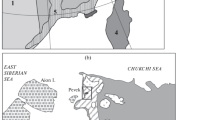Abstract
Wudalianchi (五大连池) volcanoes are famous Quaternary ones with fairly good volcanic landscape in Northeast China. The volcanic rocks are phonotephrite, tephri-phonolite, trachyandesite, and basaltic trachyandesite with SiO2 contents of 47.3 wt.%–54.2 wt.%. The characteristic of high K2O content in Wudalianchi volcanic rocks suggests that they probably share a common potassic magma source. The magma evolutions of Wudalianchi volcanic rocks are similar, while the new eruption products of Laoheishan (老黑山) and Huoshaoshan (火烧山) volcanoes are slightly more evolved than the old eruption materials, i.e., the magma of the new eruptions in 1719–1721 from the above two volcanoes is the evolved magma in underground chamber. The main phenocrysts of Wudalianchi volcanic rocks are olivines, clinopyroxenes, and some characteristic K-rich leucites. The various-shaped melt inclusions are found in olivine phenocrysts from new eruption products of Laoheishan and Huoshaoshan volcanoes. By electron microprobe (EMP) analyzing, the contents of SiO2 and total alkali show a wide range, suggesting that the pre-eruptive magma was probably more complicated, or the melt inclusions were rather unhomogeneous. On the basis of EMP results, it is believed that the sulfur degassing rate from this new eruption was much higher than that of the millennium eruption of Tianchi (天池) volcano, while the chlorine degassing rate was a magnitude lower than that of Tianchi volcano.
Similar content being viewed by others
References Cited
Bai, Z. D., Sun, S. P., Li, J. Z., et al., 1999. Cone Structure and Eruption Process of Modern Volcanoes in the Wudalianchi Area, Heilongjiang Province. Geological Review, 45(Supp1.): 369–377 (in Chinese with English Abstract)
Devine, J. D., Sigrudsson, H., Davis, A. N., et al., 1984. Estimates of Sulfur and Chlorine Yield to the Atmosphere from Volcanic Eruptions and Potential Climatic Effects. J. G. R., 89(B7): 6309–6325
Fan, Q. C., Liu, R. X., Sui, J. L., 1999. Petrology and Geochemistry of Rift Type Wudalianchi K-Rich Volcanic Rock Zone. Geological Review, 45(Supp1.): 358–368 (in Chinese with English Abstract)
Gong, J. S., 1997. Volcanic Activity of Wudalianchi Volcanic Cluster, Heilongjiang, China. Heilongjiang Geology, 8(4): 88–94 (in Chinese with English Abstract)
Gong, J. S., Xu, Y. Q., 1997. Petrology and Geochemical Characteristics of Shihlunite, from the Wudalianchi Volcanic Zone, Heilongjiang, China. Heilongjiang Geology, 8(4): 73–87 (in Chinese with English Abstract)
Guo, Z. F., Liu, J. Q., Sui, S. Z., et al., 2001. Rough Calculation of Eruptive Volcanic Gas of Baitoushan Volcano in 1199/1200 AD and Its Significance. Science in China (Series D), 31(8): 668–676 (in Chinese)
Hervig, R. L., Dunbar, N., Westrich, H. R., et al., 1989. Pre-eruptive Water Content of Rhyolitic Magmas as Determined by Ion Microprobe Analyses of Melt Inclusions in Phenocrysts. J. Volcanol. Geotherm. Res., 36(4): 293–302
Horn, S., Schmincke, H. U., 2000. Volatile Emission during the Eruption of Baitoushan Volcano (China/North Korea) ca. 969 AD. Bull. Volcanol., 61(8): 537–555
Hu, S. L., Wang, S. S., Liu, J. Q., et al., 1983. K-Ar Ages and Some Characters of Strontium, Oxygen Isotopes in Cenozoic Wudalianchi Basalts, Northeast China. Petrology Research, 2: 22–31 (in Chinese with English Abstract)
Ji, F. J., Li, Q., 1998. The TL Chronological Evidence of the Recent Eruption in Wudalianchi Volcanoes. Seismology and Geology, 20(4): 302–304 (in Chinese with English Abstract)
Li, N., 2007. A Study on Magma Degassing Effect of Holocene Explosive Eruptions of the Tianchi Volcano, Changbai Mountains: [Dissertation]. Institute of Geology, CEA, Beijing. 1–102 (in Chinese with English Abstract)
Li, Q., Chen, W. J., Li, D. M., et al., 1999. A Chronological Research on Volcanic Rocks from the Wudalianchi Area. Geological Review, 45(Suppl.): 393–399 (in Chinese with English Abstract)
Liu, R. X., 2000. Active Volcanoes in China. Seismological Press, Beijing. 44–56 (in Chinese)
Liu, Y. S., Li, J. Z., Sun, S. P., et al., 1999. The Preliminary Research on Dynamics of Volcanic Bombs from Modern Eruption in Wudalianchi Area, Heilongjiang Province. Geological Review, 45(Suppl.): 384–392 (in Chinese with English Abstract)
Lü, Z. W., Yang, S. L., 1996. Wudalianchi Volcano and Volcanic Hazard Prediction. Seismological and Geomagnetic Observation and Research, 17(6): 45–53 (in Chinese with English Abstract)
Marianelli, P., Métrich, N., Santacroce, R., et al., 1995. Mafic Magma Batches at Vesuvius: A Glass Inclusion Approach to the Modalities of Feeding Stratovolcanoes. Contrib. Mineral. Petrol., 120(2): 159–169
Marianelli, P., Métrich, N., Sbrana, A., 1999. Shallow and Deep Reservoir Involved in Magma Supply of the 1944 Eruption of Vesuvius. Bull. Volcanol., 61(1–2): 48–63
Marianelli, P., Sbrana, A., Métrich, N., et al., 2005. The Deep Feeding System of Vesuvius Involved in Recent Violent Strombolian Eruptions. Geophysical Research Letters, 32(2): L02306
Métrich, N., Allard, P., Spilliaert, N., et al., 2004. Flank Eruption of the Alkali- and Volatile-Rich Primitive Basalt Responsible for Mount Etna’s Evolution in the Last Three Decades. Earth and Planetary Science Letters, 228(1–2): 1–17
Middlemost, E. A. K., 1994. Naming Materials in the Magma/Igneous Rock System. Earth-Science Reviews, 37: 215–224
Ren, J. Z., Chen, H. Z., 1999. On the Eruption Process and Special Eruptive Type of the Laoheishan and Huoshaoshan Volcanoes in Wudalianchi. Geological Review, 45(Suppl.): 378–383 (in Chinese with English Abstract)
Santacroce, R., Bertagnini, A., Civetta, L., et al., 1993. Eruptive Dynamics and Petrogenetic Processes in a Very Shallow Magma Reservoir: The 1906 Eruption of Vesuvius. J. Petrol., 34(2): 383–425
Villemant, B., Trigila, R., de Vivo, B., 1993. Geochemistry of Vesuvius Volcanics during 1631–1944 Period. J. Volcanol. Geotherm. Res., 58(1–4): 291–313
Wang, J. W., Xie, G. H., 1992. The Geochemistry of Wudalianchi Potassic Lava. In: Liu, R. X., ed., Chronology and Geochemistry of Cenozonic Volcanic Rocks in China. Seismological Press, Beijing. 213–227 (in Chinese)
Wang, J. W., Xie, G. H., Tatsumoto, M., et al., 1988. Sr, Nd, Pb Isotope Geochemistry and Magma Evolution of Potash Volcanic Rocks at Wudalianchi. Geochimica, (4): 310–318 (in Chinese with English Abstract)
Xia, L. Q., Cheng, S. L., Huang, Y. H., 1986. Magmatic Inclusions in Minerals in Alkali-Basalts from Wudalianchi and Jining, China. Acta Mineralogica Sinica, 6(1): 51–58 (in Chinese with English Abstract)
Xia, L. Q., Liu, W. F., Tang, N. A., 1990. Abundances of Fluorine, Chlorine, Sulfur and Phosphorus and Their Evolution in Volcanic Magmas from Wudalianchi. Geochimica, (3): 197–206 (in Chinese with English Abstract)
Xia, L. Q., 1990. On the Evolution of Volcanic Magma from Wudalianchi, China. Acta Petrologica Sinica, 1: 13–29 (in Chinese with English Abstract)
Xu, Y. Q., 1997. History of the Volcanic Activity of Laoheishan Volcano and Its Relationship to the Formation and Evolution of Wudalianchi Volcanic Cluster, Heilongjiang, China. Heilongjiang Geology, 8(4): 51–63 (in Chinese with English Abstract)
Zhang, M., 1984. Petrologic Characteristics of Shihlunite from Laoheishan and Huoshaoshan of Wudalianchi, Heilonjiang Province. Earth Science—Journal of Wuhan College of Geology, 1: 87–99 (in Chinese with English Abstract)
Author information
Authors and Affiliations
Corresponding author
Additional information
This study was jointly supported by the National Eleventh Five-Year Plan, Short Term Prediction of Strong Earthquake and a Study on Hazard Relief (No. 2006BAC01B040104), of China, the Joint Earthquake Science Foundation of China Earthquake Administration (No. 106052), and the State Key Laboratory for Mineral Deposits Research, Nanjing University (No. 12-06-05).
Rights and permissions
About this article
Cite this article
Li, N., Fan, Q., Sun, Q. et al. Lithogeochemistry of volcanic rocks and hosted melt inclusions in Wudalianchi, Heilongjiang, China. J. Earth Sci. 20, 771–783 (2009). https://doi.org/10.1007/s12583-009-0067-3
Received:
Accepted:
Published:
Issue Date:
DOI: https://doi.org/10.1007/s12583-009-0067-3




